| 
Mathura
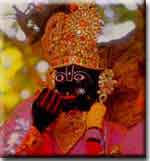
The
land where Lord Krishna was born and spent his youth, has today little towns and
hamlets that are still alive with the Krishna- legend and still redolent with
the music of his flute. Mathura, a quiet town on the River Yamuna was
transformed into a place of faith after Lord Krishna was born here. Vrindavan, a
village - once noted for its fragrant groves, is where he spent an eventful
youth. There are numerous other little spots in the area that still reverberate
with the enchantment of Lord Krishna. The city of Mathura, in Uttar
Pradesh, the nucleus of Brajbhoomi, is located at a distances
of 145 km south- east of Delhi and 58 km north-west of Agra. Covering an area of
about 3,800 sq. km. today, Brajbhoomi can be divided into two distinct units -
the eastern part in the trans-Yamuna tract with places like Gokul, Mahavan,
Baldeo, Mat and Bajna and the western side of the Yamuna covering the Mathura
region that encompasses Vrindavan, Govardhan, Kusum Sarovar, Barsana and
Nandgaon. The land of Braj
starts from Kotban near Hodel about 95 km from Delhi and ends at Runakta which
is known specially for its association with the great poet Surdas, an ardent
Krishna devotee. Shri Krishna is
fondly remembered for his charm, his mischievous pranks and his extraordinary
exploits. As the charioteer and preceptor to Arjun in the famous battle of
Kurukshetra, he revealed to the world the supreme truths of life. Shri Krishna,
an incarnation of Lord Vishnu, was born in the Dwapara Yuga as the eighth son of
the Yadava prince Vasudev and his wife Devaki. To save him from his maternal
uncle Kansa wrath, the infant Krishna was spirited away soon after birth to
Gokul, the village of the gopas (cowherds) in Braj. It was here that he grew to
manhood, in the tender care of his foster parents Nand and Yashoda in the happy
company of the cowherds. Top MATHURA 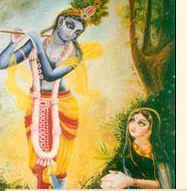
A long line of
picturesque Ghats - with their steps leading to the water's edge, arched
gateways and temple spires extending along the right bank of the River Yamuna,
emphasis the sacred character of the town of Mathura. The birth place of Lord
Krishna, "the best known, best loved and most complex of Lord Vishnu's
manifestations" - Mathura is today an important place of pilgrimage. The
city stretches along the right bank of the Yamuna and the continuous line of
Ghats along the river makes a splendid spectacle when viewed from the opposite
bank Today, Mathura is
a city of temples and shrines abustle with the thousands of devotees who come to
visit the city of Lord Krishna. A splendid temple at the Katra Keshav Dev marks
the spot that is believed to be the Shri Krishna Janmasthan - the birthplace of
the Lord, by his devotees. Another beautiful shrine, the Gita Mandir, located on
the Mathura -Vrindavan Road has a fine image of Shri Krishna in its sanctum. The
whole of the Bhagwad Gita is inscribed on the walls of this temple. The most popular
shrine at Mathura is the Dwarikadhish Temple to the north of the town, dedicated
to Shri Krishna. This was built in 1815 by a staunch and wealthy devotee, Seth
Gokuldas Parikh, Treasurer of the State of Gwalior. It is at Vishram
Ghat that the traditional parikrama (circumbulation of all the important
religious and cultural places of the city) starts and ends. The 12 Ghats to the
north of Vishram Ghat include the Ganesh Ghat, Dashashwamedh Ghat with its
Neelakantheshwar Temple, Saraswati Sangam Ghat, Chakratirtha Ghat, Krishnaganga
Ghat, Somatirth or Swami Ghat, Ghantagharan Ghat, Dharapattan Ghat, Vaikuntha
Ghat, Navtirtha or Varahkshetra Ghat, Asikunda ghat and Manikarnika Ghat. To the
south, there are 11 Ghats - the Guptatirth Ghat, Prayag Ghat marked by the Veni
Madhav Temple, Shyam Ghat, Ram Ghat, Kankhal Ghat, the site of the Janmashtami
and Jhula festivals, Dhruva ghat, Saptrishi Ghat, Mokshatirth Ghat, Surya Ghat,
Ravan Koti Ghat and Buddha Ghat.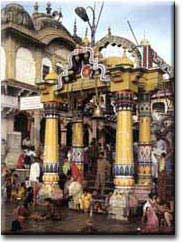 The Vishram Ghat
is lined with elegant temples and some of Mathura's most important shrines are
found here - the Mukut Temple, Radha-Damodar, Murli Manohar, Neelkantheshwar,
Yamuna-Krishna, Langali Hanuman and Narasimha temples. The baithak of the great
Vaishnava Saint, Shri Chaitanya, is also near by. The aarti held at
the Vishram Ghat each evening is not to be missed, for the little oil lamps that
are floated on the river set the placid water as sparkle with a myriad
flickering lights. No pilgrimage to
Mathura is complete without a visit to its kunds. Tradition has it that there
were 159 ancient kunds in all. Of these only four survive and can be seen. There
is the elegant shiv Tal, the more famous Potara Kund associated closely with
Lord Krishna besides the Balbhadra and Saraswati kunds. The town has a
number of Shaivite temples as well. The chief among them being the Bhuteshwar
Mahadev Temple to the west of the town, the Gokarneshwar Temple in the north,
the Rangeshwar. Mahadev Temple to the south and the Pipaleshwar Mahadev Temple
to the east. Top Vrindavan 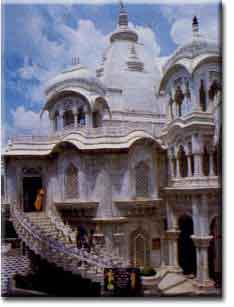
Vrindavan, just
15 km from Mathura, is another major place of pilgrimage. It is noted for its
numerous temples - both old and modern. The name Vrindavan evokes the
playfulness and lovable characteristics of Shri Krishna. This is the wood where
he frolicked with the gopis and tenderly wooed Radha. Vrindavan today,
is noted for its numerous temples. The most important are : The Madan Mohan
Temple 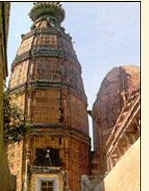 Located near the Kali Ghat which was built by Kapur Ram DAs of
Multan.
This is the oldest existent temple in Vrindavan today. The temple is closely
associated with the saint Chaitanya. The original idol of Lord Madan Gopal was
shifted from the shrine to Karauli in Rajasthan for safe keeping, during
Aurangzeb's rule. Today, replica of the image is worshipped at the temple. Located near the Kali Ghat which was built by Kapur Ram DAs of
Multan.
This is the oldest existent temple in Vrindavan today. The temple is closely
associated with the saint Chaitanya. The original idol of Lord Madan Gopal was
shifted from the shrine to Karauli in Rajasthan for safe keeping, during
Aurangzeb's rule. Today, replica of the image is worshipped at the temple.
The Banke Bihari
Temple built in 1864 is the most popular shrine at Vrindavan. The image of Banke
Bihari was discovered in Nidhi Vana by Swami Haridas Ji, the great Krishna
devotee, belonging to the Nimbarka sect. Top The Rangaji
Temple 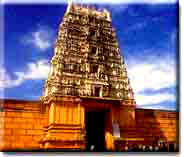 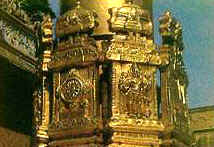
Built in 1851, is dedicated to Lord Ranganatha or Rangaji depicted as
Lord Vishnu in his Sheshashayi pose, resting on the coils of the sacred Sheesh-nag.
The temple built in the Dravidian style has a tall gopuram (gateway) of six
storeys and a gold plated Dhwaja Stambha, 50 feet high. A water tank and a
picturesque garden lie within the temple enclosure. The annual festival of Jal
Vihar of the presiding deity is performed with great pomp and splendor at the
tank. The temple is also famous for its 'Brahmotsav' celebration in March-April,
more popularly known as the 'Rath Ka Mela'. The ten day long celebrations are
marked by the pulling of the rath (the chariot car) by the devotees from the
temple to the adjoining gardens. Govardhan Govardhan is
situated 26 km west of Mathura on the state highway to Deeg. A famous place of
Hindu pilgrimage, Govardhan is located on a narrow sandstone hill known as
Giriraj which is about 8 km in length. The young Lord Krishna is said to have
held Giriraj up on the tip of a finger for 7 days and nights to shield the
people of Braj from the deluge of rain sent down by Lord Indra. Govardhan is set
along the edge of a large masonry tank known as the Mansi Ganga, which is
believed to have been brought into existence by the operation of the divine
will. Its enclosures were built by Raja Bhagwan DAs of Amer in 1637 and
embellished by Raja Man Singh, who built a long flight of steps leading up, from
the end of the tank. Close by is the famous red sandstone temple of Haridev and
the Kusum Sarovar with exquisitely carved chhatris - the cenotaphs of the
members of the royal family of Bharatpur, who perished whilst fighting against
the British in 1825. Towards the south is the beautiful chhatri of Raja Surajmal
of Bharatpur. Fine frescoes - illuminating the life of Surajmal, vividly depict
darbar and hunting scenes, royal processions and wars. Top
|



